Evidence of liquid oceans on Saturn's moon Enceladus increases chances of finding alien life in our Solar System

One of the moons of Saturn has turned out to be another possible habitat for extraterrestrial microbes after scientists have discovered that it possesses a large ocean of water beneath its icy surface.
Measurements of gravity fluctuations around Enceladus taken by Nasa’s Cassini spacecraft indicate that there is an underground ocean of melted water at the moon’s south pole which may be the source of dramatic vapour plumes seen at its surface.
The existence of liquid water is widely assumed to be a vital precondition for life so its presence suggests that Enceladus may be another habitable part of the Solar System, along with Titan, the biggest moon of Saturn, and Europa, an ice-covered moon of Jupiter.
A study led by Luciano Iess of Sapienza University in Rome, published in the journal Science, shows that during three flybys of Enceladus between 2010 and 2012, which brought Cassini within 100km (62 miles) of its surface, the spacecraft’s velocity changed slightly in response to fluctuations in the moon’s gravity field, which could only be readily explained by the presence of a large body of liquid water at its south pole.
“Using geophysical measurements, we have been able to confirm that there is a large ocean beneath the surface of Enceladus’s south-polar region. This provides a possible source for the water that Cassini has seen spewing from the geysers in this region,” said Professor David Stevenson, a co-investigator at the California Institute of Technology in Pasadena.
“This water ocean may extend halfway or more towards the equator [of Enceladus] in every direction. This means that it is as large, or larger, than Lake Superior [the largest of the Great Lakes],” Professor Stevenson said.
The Cassini spacecraft observed the water plumes on Enceladus in 2005 to the surprise of astronomers given that the surface temperatures on the moon, which is barely 500km wide, hover around minus 180C and the lunarscape is covered in a thick crust of solid ice.
Calculations suggest that the liquid ocean is located at a depth of between 30km and 40km beneath the surface and is prevented from freezing up completely by the geophysical heat generated by the tidal forces on the moon as it completes its elliptical orbit around Saturn.
“Enceladus shows some similarity to Europa, a much larger moon of Jupiter, which, like Enceladus has an ocean that is in contact with underlying rock. In this respect these two bodies are of particular interest for understanding the presence and nature of habitable environments in our Solar System,” Professor Stevenson said.
“The data suggest that indeed there is a large, possibly regional ocean about 50km below the surface of the south pole. This then provides one possible story to explain why water is gushing out of these fractures we see at the south pole,” he said.
Liquid water is denser than ice – which is why ice floats on water – and this difference in density deep under the frozen surface causes fluctuations in the moon’s gravity field, which resulted in Cassini slowing down by a few millimetres per second as it flew past Enceladus. Calculations suggest the ocean is 10km deep.
Although there is no direct evidence connecting the underground ocean to the surface plumes of salty water vapour, the astronomers believe the two are connected via a network of “tiger stripes” or fractures in the ice that can be seen from space.
“Material from Enceladus’s south polar jets contains salty water and organic molecules, the basic chemical ingredients for life,” said Linda Spilker, the Cassini project scientist at Nasa’s Jet Propulsion Laboratory in Pasadena.
“Their discovery expanded our view of the ‘habitable zone’ within our solar system and in planetary systems of other stars. This new validation that an ocean of water underlies the jets furthers understanding about this intriguing environment,” Dr Spilker said.
Join our commenting forum
Join thought-provoking conversations, follow other Independent readers and see their replies
Comments